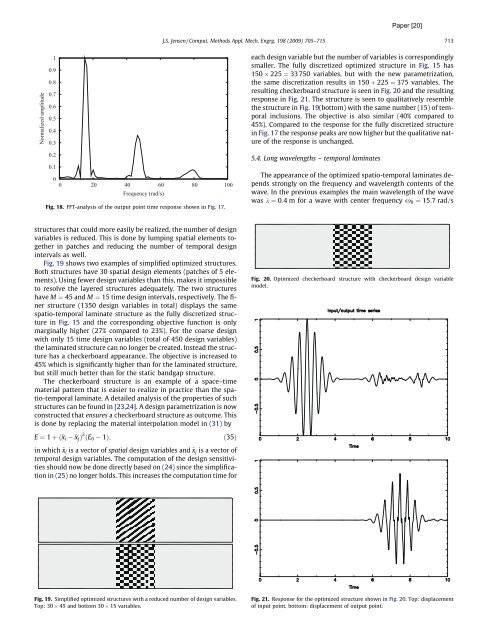WAVES AND VIBRATIONS IN INHOMOGENEOUS STRUCTURES ...
WAVES AND VIBRATIONS IN INHOMOGENEOUS STRUCTURES ...
WAVES AND VIBRATIONS IN INHOMOGENEOUS STRUCTURES ...
You also want an ePaper? Increase the reach of your titles
YUMPU automatically turns print PDFs into web optimized ePapers that Google loves.
Normalized amplitude<br />
1<br />
0.9<br />
0.8<br />
0.7<br />
0.6<br />
0.5<br />
0.4<br />
0.3<br />
0.2<br />
0.1<br />
0<br />
0 20 40 60 80 100<br />
Frequency (rad/s)<br />
Fig. 18. FFT-analysis of the output point time response shown in Fig. 17.<br />
structures that could more easily be realized, the number of design<br />
variables is reduced. This is done by lumping spatial elements together<br />
in patches and reducing the number of temporal design<br />
intervals as well.<br />
Fig. 19 shows two examples of simplified optimized structures.<br />
Both structures have 30 spatial design elements (patches of 5 elements).<br />
Using fewer design variables than this, makes it impossible<br />
to resolve the layered structures adequately. The two structures<br />
have M ¼ 45 and M ¼ 15 time design intervals, respectively. The finer<br />
structure (1350 design variables in total) displays the same<br />
spatio-temporal laminate structure as the fully discretized structure<br />
in Fig. 15 and the corresponding objective function is only<br />
marginally higher (27% compared to 23%). For the coarse design<br />
with only 15 time design variables (total of 450 design variables)<br />
the laminated structure can no longer be created. Instead the structure<br />
has a checkerboard appearance. The objective is increased to<br />
45% which is significantly higher than for the laminated structure,<br />
but still much better than for the static bandgap structure.<br />
The checkerboard structure is an example of a space–time<br />
material pattern that is easier to realize in practice than the spatio-temporal<br />
laminate. A detailed analysis of the properties of such<br />
structures can be found in [23,24]. A design parametrization is now<br />
constructed that ensures a checkerboard structure as outcome. This<br />
is done by replacing the material interpolation model in (31) by<br />
E ¼ 1 þð~xi ~xjÞ 2 ðE0 1Þ; ð35Þ<br />
in which ~xi is a vector of spatial design variables and ~xj is a vector of<br />
temporal design variables. The computation of the design sensitivities<br />
should now be done directly based on (24) since the simplification<br />
in (25) no longer holds. This increases the computation time for<br />
Fig. 19. Simplified optimized structures with a reduced number of design variables.<br />
Top: 30 45 and bottom 30 15 variables.<br />
J.S. Jensen / Comput. Methods Appl. Mech. Engrg. 198 (2009) 705–715 713<br />
each design variable but the number of variables is correspondingly<br />
smaller. The fully discretized optimized structure in Fig. 15 has<br />
150 225 ¼ 33750 variables, but with the new parametrization,<br />
the same discretization results in 150 þ 225 ¼ 375 variables. The<br />
resulting checkerboard structure is seen in Fig. 20 and the resulting<br />
response in Fig. 21. The structure is seen to qualitatively resemble<br />
the structure in Fig. 19(bottom) with the same number (15) of temporal<br />
inclusions. The objective is also similar (40% compared to<br />
45%). Compared to the response for the fully discretized structure<br />
in Fig. 17 the response peaks are now higher but the qualitative nature<br />
of the response is unchanged.<br />
5.4. Long wavelengths – temporal laminates<br />
The appearance of the optimized spatio-temporal laminates depends<br />
strongly on the frequency and wavelength contents of the<br />
wave. In the previous examples the main wavelength of the wave<br />
was k ¼ 0:4 m for a wave with center frequency x0 ¼ 15:7 rad=s<br />
Fig. 20. Optimized checkerboard structure with checkerboard design variable<br />
model.<br />
Fig. 21. Response for the optimized structure shown in Fig. 20. Top: displacement<br />
of input point, bottom: displacement of output point.

















